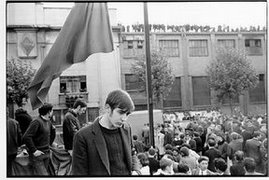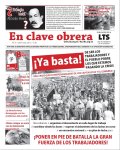40 years
The French May 1968
26/05/2008

Forty years have passed since the French May, and visions that present the events merely as a “student revolt” or a “cultural rebellion” are multiplying. Daniel Cohn-Bendit himself, a student leader of those days, in his capacity as a Deputy of the European Parliament now maintains that “the revolt had as its aim confronting the moral atmosphere, an authoritarian conception of life, authoritarian morals.”
This is a limited interpretation or, more accurately, a way of diminishing what the French May really was: a magnificent process of struggle and of student political radicalization that opened a road to the biggest general strike in the history of France and insubordination of working-class youth, defying authority in those days of May.
The antecedents of May
“May” did not fall like a lightning bolt in a peaceful sky. The conditions that made it possible were given by different events provoked after the Second World War. And these were preparing the political and ideological climate of that year.
Stalinism was losing prestige. To its “peaceful coexistence” with capitalism was added the revelation of Stalin’s crimes and the repression of the 1956 Hungarian Revolution, crushed by Soviet tanks. Together with this, the Chinese-Soviet conflict was provoking a split in monolithic “official communism” and facilitating the rise of tendencies to the left of the Communist Parties.
On the other hand, revolutions in the colonial and semi-colonial countries, like the Cuban Revolution of 1959, were welcomed with enthusiasm the world over, and Che Guevara, murdered in Bolivia in 1967, became a banner of leftist youth.
But in France itself, one event was going to be highly significant: the anti-colonial war of Algeria (1954 - 1962). The war, showing the brutality of French imperialism, will have a strong impact on French youth: the day of the victory of Algeria’s independence, students of the Sorbonne are going to raise the flag of the Algerian National Liberation Front. People began to break with the leadership of the French Communist Party (PCF) that had offered “critical support” to the French government during the war.
However, the event that would be decisive in the prelude to 1968 was the war in Vietnam. A turning point would take place at the beginning of 1968. US optimism was beginning to collapse, since the Vietcong launched an offensive at the end of January of that year against the capital of Vietnam, besieged Saigon, and the US Embassy itself is attacked by a suicide commando team. Now nothing was simple for the US.
Like their US peers, French youth move to the front of the mobilizations against the war. Unlike the PCF, which was holding poorly-attended marches with abstract content: “Peace for Vietnam,” the radicalized organizations and activists seize the anti-imperialist struggle by organizing grassroots committees in neighborhoods, on campuses and in high schools, calling together tends of thousands of French youth to fight for driving the US out of Vietnam. The idea that imperialism could be defeated was already being prepared in the streets.
On March 20, during a protest march against US intervention, some 300 activists from the National Vietnam Committee break the glass windows of the American Express bank in Paris. The police immediately grab several demonstrators, among them Xavier Langlade, a Trotskyist leader of the Revolutionary Communist Youth (JCR). In opposition to the arrests, 150 students occupy the administrative councils of the Nanterre campus. The “March 22” movement, uniting the entire vanguard of Nanterre, was born. In particular, Daniel Cohn-Bendit stands out at its head, with the Trotskyist Daniel Bensaid.
The imagination to power
To this feeling of social and cultural opposition against capitalism the youths were experiencing, is added the repudiation of the university reform (the Plan Fouchet: modification of the curricula and new required courses). Everything begins to be called into question. The students summarize it with a phrase: “From criticism of the class university to questioning class society.”
The model of teaching in the bourgeois university and the relation between “educators” and “those educated” are also being repudiated. Against the entrance exam and the attempt to exclude those who failed courses, the student movement reponds: “Down with selection!” Mobilizations had been occurring since the end of 1967, with a strike called by the National Union of Students of France (UNEF). High school students, who are prohibited from political activity inside schools, join the struggle.
Student protests in Nanterre are answered with repression, and eight students are seized, among them Cohn Bendit. On May 2, this campus is cleared out and shut down.
The next day, 500 people gather in the courtyard of the Sorbonne in solidarity with the Nanterre 8. Police enter the university, arresting several demonstrators. That day, the first cobblestones are thrown at the forces of repression in the Latin Quarter. During the days following, the student mobilizations will grow in magnitude, and the first barricades appear.
For its part, the PCF attacks the mobilizations, describing them as actions of “small leftist groups,” while the government closes the Sorbonne.
With the support of the population, all the universities of France go on strike for the release of those arrested, for reopening all the campuses and withdrawing the cops.
On May 10, barricades multiply in the Latin Quarter. “The night of the barricades” will be the dawn of the big movement of the French May, an historic day on which students and working-class youths (spontaneously arriving from the suburbs of Paris) fight heroically until dawn of the following day, resisting the repression unleashed. It was the beginning of worker-student unity.
The student movement’s struggle moved up and detonated the workers’ movement’s entrance on the stage. In May, the students acted as a sensitive layer expressing the contradictions of the entire society: disagreement with the conservatism of daily life, loathing for De Gaulle’s Bonapartist regime and the workers’ malaise in the factories. The ideological radicalism of the students and their methods of struggle, were a direct questioning against the French capitalist regime, opening a political crisis.
Part of this questioning will also be profound criticism of the bureaucratic apparatus of the PCF and its conciliating politics, that will allow the strengthening of the “extreme left” where the Trotskyist groups will acquire a lot of weight.
From the barricades to the general strike
The PCF enjoyed iron control over the workers’ movement. Now, under pressure from the rank and file, the trade union federations are forced to call the general strike for May 12 throughout France. In this way, the working class will burst into the national crisis. The bureaucracy was trying to reduce the strike to partial demands, but the strike was already acquiring a political character: “Ten years are enough!” the demonstrators chant, referring to a decade of Gaullist rule. On May 14 and 15, seizures of factories and strikes spread throughout the country.
With action by the workers, the student movement gets a new boost. Worker-student unity increases: thousands of working-class youths march to the Latin Quarter to express their solidarity with the students, who respond by mobilizing to the seized factories with the shout, “Take the banner of struggle from our frail hands.” This unity will be targeted for attack by the PCF union leaders. Besides rejecting “outside interference,” they call for “fighting and isolating all the small ‘leftist’ groups that are trying to damage the democratic movement by hiding behind revolutionary phraseology.”
The PCF has to put itself at the head of the strike to limit it as much as possible. Despite the PCF, the strike spreads throughout France. Ten million workers are on strike. It is the biggest general strike in the history of the country and one of the biggest in the workers movement in the West.
Betrayal
To try to curb the torrent unleashed, the CGT and the government implement the Grenelle agreements (wage raises are offered in exchange for a return to work). But on their arrival at the main factories with the proposal, the union leaders are jeered. “The struggle continues,” the workers answer.
The PCF will then have to modify its strategy to deactivate the movement. Now the way is to negotiate the workers’ demands sector by sector, in an attempt to atomize and divide.
The decisive break will take place on May 30. De Gaulle announces the dissolution of the National Assembly (the parliament), the calling of elections, moved forward, and the “re-establishment of order.” The CGT and the PCF accept, guaranteeing “the return to normalcy,” by trading the struggle for the elections. The union bureaucracy negotiates small wage raises and union rights during the first days of June. Slowly, the return to work begins.
The betrayal was completed, opening the door to the harshest repression against the vanguard of the workers and students. Beginning on June 7, the most violent days take place, through clearing out the factories and confrontations with the police, where several workers and students lose their lives. On June 12, the government decrees the dissolution of the political organizations of the far left and begins arresting its main leaders.
The last bastions to fall will be two of the symbols of May: on June 17 the Sorbonne is cleared out, and between June 17 and 24, the automotive workers, who are the last to abandon the struggle, return to work. In this way, the regime manages to take the crisis toward the parliamentary terrain, and elections are held on June 23 and 30. De Gaulle and the right wing consecrate their victory at the polls: the working class had refused to vote for the PCF.
Conclusions
What was “May”? In the first place, a profound cultural, social and political criticism of capitalism, a protest against all the injustices and inequalities brought about by the system. May witnessed the radicalization of students and working-class youths, the vanguard of a general strike that disputed, in actions, who owned the power. Through the action of the masses, De Gaulle’s fall was possible, and, in this sense, the situation was as revolutionary as the leaders allowed.
In spite of the fact that sectors of the vanguard clashed with the PCF, they could not come close to creating widespread bodies for self-organization, nor was there in existence a revolutionary leadership that could overcome the PCF’s betrayal. The Trotskyist organizations had arrived at May too weak to be an alternative.
The workers and the students could not win. However, their struggle had an indisputable merit: the banners of May 1968 were the spearhead of events like the Hot Autumn in Italy, the Prague Spring, the Revolution of the Carnations in Portugal, the Córdoba uprising in Argentina, the Cordones Industriales [workers’ self-defense organizations] in Chile, and an endless list of workers’ and students’ uprisings the world over.
May will be the beginning of a rise of class struggle in the semi-colonial countries, in the imperialist centers, and in the workers’ states of the East. It inaugurated a revolutionary decade that disputed the bourgeois order and also the reformist and bureaucratic leaderships like the Stalinist apparatus.
Translation by Yosef M.







